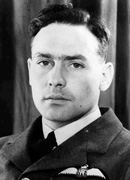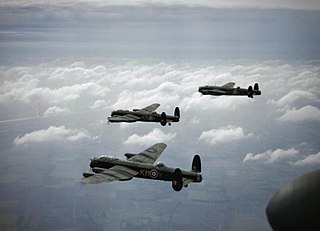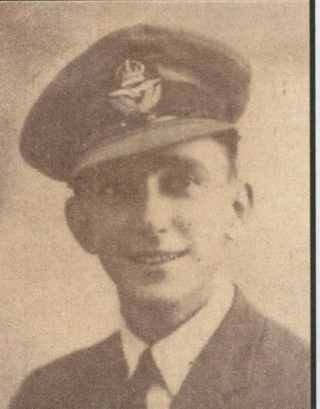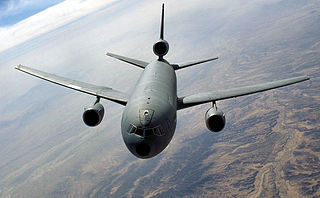Related Research Articles

John Dering Nettleton, VC was a South African officer in the Royal Air Force (RAF) during the Second World War. He is most famous for leading the Augsburg raid, a daylight attack against the MAN U-boat engine plant in Augsburg on 17 April 1942. For his role in this mission he was awarded the Victoria Cross, the highest award for gallantry in the face of the enemy that can be awarded to British and Commonwealth forces.

No. 486 (NZ) Squadron was a fighter squadron established for service during the Second World War. It was a New Zealand squadron formed under Article XV of the Empire Air Training Plan. Although many of its flying personnel were largely drawn from the Royal New Zealand Air Force, the squadron served in Europe under the operational and administrative command of the Royal Air Force.

The bombing of Augsburg in World War II included two British RAF and one USAAF bombing raids against the German city of Augsburg on 17 April 1942 and 25/26 February 1944.

Operation Bellicose was an attack by Avro Lancaster bombers of the Royal Air Force on a German radar factory housed in the former Zeppelin Works at Friedrichshafen and the Italian naval base at La Spezia. It was the first shuttle bombing raid in the Second World War and the second use of a Master Bomber. In early June 1943, a Central Interpretation Unit photo interpreter identified a stack of ribbed baskets at the Zeppelin Works. After Winston Churchill viewed the photos at RAF Medmenham on 14 June, No. 5 Group RAF received the surprise orders on 16 June to attack Friedrichshafen during the next full moon.
Karl-Heinz Greisert was an officer in the Luftwaffe. He served in the Condor Legion during the Spanish Civil War. During the Second World War he participated in the air battles over France and England. He was made commanding officer of II Gruppe of Jagdgeschwader 2. For three months he served as acting commander of JG 2 after his commander had been killed in action. Following the Battle of Britain he remained in the west and was involved in a number of air battles over the English Channel and northern France. In June 1942 he was transferred to the eastern Front where he took command of III Gruppe of JG 3. A month later he was killed in action in the course of a low altitude air battle. He was credited with 34 victories, and was a recipient of the Spanish Cross and the German Cross in Gold.

Number 44 (Rhodesia) Squadron was an aviation unit of the Royal Air Force. It was active between 1917 and 1982. For most of its history it served as a heavy bomber squadron.

Raymond Brown Hesselyn, was a New Zealand fighter pilot and flying ace of the Second World War, credited with the destruction of at least 18 enemy aircraft while flying with the Royal Air Force (RAF) over Europe and the Mediterranean.

Group Captain James Brian "Willie" Tait, was an officer in the Royal Air Force during and after the Second World War. He conducted 101 bombing missions during the war, including the one that finally sank the German battleship Tirpitz in 1944. He succeeded Leonard Cheshire as commander of the famous 617 Squadron and with six gallantry decorations to his name, remains one of the most distinguished airmen in the history of the nations of the British Commonwealth.

Derek Harland Ward, was a New Zealand flying ace of the Royal Air Force (RAF) during the Second World War. He was credited with six confirmed victories and one probable.

The 305th Operations Group is a United States Air Force unit assigned to the 305th Air Mobility Wing. It is stationed at the McGuire AFB entity of Joint Base McGuire-Dix-Lakehurst, New Jersey.

The de Havilland Mosquito was a British light bomber that served in many roles during and after the Second World War. Mosquito-equipped squadrons performed medium bomber, reconnaissance, tactical strike, anti-submarine warfare and shipping attack and night fighter duties, both defensive and offensive. Mosquitos were widely used by the RAF Pathfinder Force, which marked targets for night-time strategic bombing. Despite an initially high loss rate due to low-level daylight attack operations, the Mosquito ended the war with the lowest losses of any of the aircraft types in RAF Bomber Command service.

The 91st Operations Group is the operational component of the 91st Missile Wing, assigned to the Air Force Global Strike Command Twentieth Air Force. It is stationed at Minot Air Force Base, North Dakota.

Fraser Barron DSO & Bar, DFC, DFM, was an officer of the Royal New Zealand Air Force (RNZAF) who flew as a pilot with Bomber Command and was killed in flying operations during World War II.

David John Shannon, DSO & Bar, DFC & Bar was an Australian bomber pilot of World War II, known for his part in the "Dambusters" raid on the night of 16/17 May 1943. Born in South Australia, Shannon joined the Royal Australian Air Force (RAAF) in 1941 and learned to fly under the Empire Air Training Scheme. After further training in the United Kingdom he was posted to No. 106 Squadron RAF, operating Avro Lancaster heavy bombers, and was awarded the Distinguished Flying Cross (DFC) in January 1943.

No. 485 (NZ) Squadron was a fighter squadron established for service during the Second World War. It was the first New Zealand squadron formed under Article XV of the Empire Air Training Plan. Although many of its flying personnel were largely drawn from the Royal New Zealand Air Force, the squadron served in Europe under the operational and administrative command of the Royal Air Force.
Osgood Philip Villiers "Pedro" Hanbury, was a Royal Air Force flying ace of the Second World War. He had scored 11 victories before he was killed in action in 1943.

The Augsburg Raid, also referred to as Operation Margin, was a bombing raid made by the RAF on the MAN U-boat engine plant in Augsburg undertaken during the daylight hours of 17 April 1942. The mission was assigned to No. 44 (Rhodesia) Squadron and No. 97 Squadron, both of which were equipped with the new Avro Lancaster. The speed of the Lancaster and its large bombload capacity gave reason for optimism that the raid might succeed. It was the first of the attacks upon German industry in Augsburg.

Patrick Arthur Dorehill, was an officer in the Royal Air Force. A bomber pilot, he flew as flight engineer for John Nettleton during the Augsburg raid, where they carried out a daring daylight attack against the MAN U-boat engine plant at Augsburg in southern Germany, earning him an immediate DFC and his captain the Victoria Cross. He completed two full combat tours as a bomber pilot. With his commitment to combat flying completed, he was transferred to the BOAC where he flew transports. Following the war Dorehill had a lengthy career as a commercial airline pilot.

Operation Oyster was a bombing raid made by the Royal Air Force (RAF) on 6 December 1942 upon the Philips works at Eindhoven, Netherlands. The Philips company was a major producer of electronics equipment, including vacuum tubes for radio communication. Prior to the Battle of the Netherlands in 1940, Philips was known to be a leading research firm in infrared and radar technology. To ensure accuracy and minimise casualties among the Dutch citizens, the raid had to be undertaken during the day.

Irving Stanley Smith was a New Zealand flying ace of the Royal New Zealand Air Force (RNZAF) during the Second World War, who subsequently transferred to the Royal Air Force (RAF). He was credited with the destruction of eight enemy aircraft.
References
- 1 2 "Hedge-hop men honoured and VC for the leader · IBCC Digital Archive". ibccdigitalarchive.lincoln.ac.uk. Retrieved 2024-02-28.
- ↑ "Operation Hedge-Hop!"Warfront,vol. 1,no. 18,p. 24/1(Dec 1951 (US)).Harvey Picture Magazine, Inc.
- ↑ "GCD :: Issue :: Fighting Fronts #2". Grand Comics Database . Retrieved 27 September 2011.
- ↑ "Aces Low!"War Battles,vol. 1,no. 1,pp. 26–30(Feb-Mar 1952 (US)).Harvey Picture Magazine, Inc.